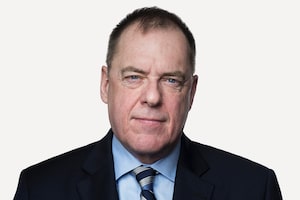Ontario's Premier Doug Ford, accompanied by Canada's Prime Minister Justin Trudeau, answers questions from the media at the Stellantis Research and Development Centre in Windsor on May 2.REBECCA COOK/Reuters
On Monday, one day before the formal launch of the Ontario election campaign, Justin Trudeau and Doug Ford stood together to announce federal and provincial support for a $3.6-billion investment in auto plants in Windsor and Brampton to produce electric vehicles.
“What is Trudeau doing?” fumed Liberal strategist David Herle. Why, he wondered, would the Liberal Prime Minister boost the Progressive Conservative Premier on the eve of an election campaign? Ontario Liberal Leader Steven Del Duca “should try to get Trudeau defined as a third party to at least limit his spending,” Mr. Herle tweeted, mockingly.
Three years ago, it suited Mr. Trudeau and Mr. Ford to make war on each other over the Liberal carbon tax. Now the two are allies. Mr. Trudeau must have known that appearing with Mr. Ford at the funding announcement would hurt the electoral prospects of the Ontario Liberals, yet he did it anyway. Why? For three reasons.
First and foremost, both political leaders recognize the vital importance of supporting the auto industry as it transitions to electric vehicles from internal combustion engines. Monday’s announcement was the latest in a series of similar federal-Ontario investments.
“Mr. Trudeau and Mr. Ford are seeing eye to eye on the necessity to invest in this specific domain,” said Stéphanie Chouinard, a professor of political science at Queen’s University who studies federal-provincial relations. “All of this is bigger than one election.”
Trudeau and Ford’s political bromance is bad news for opposition parties
Second, the announcement signals that the federal Liberals expect to be working with a Progressive Conservative government at Queen’s Park after the June 2 vote. There’s good reason to think that. Polling aggregator 338Canada projects that, if a vote were held today, the Progressive Conservatives would be returned with a comfortable majority government and 39 per cent of the vote. The only question is whether Mr. Del Duca’s Liberals or Andrea Horwath’s NDP would form the official opposition.
Third, the newfound spirit of co-operation suggests that “Doug Ford has grown into his role as leader of the Progressive Conservative Party and grown up as a politician,” said Anna Esselment, a political scientist at University of Waterloo who studies intergovernmental relations.
The Doug Ford of today is much easier for Mr. Trudeau to get along with than the Doug Ford of three years ago. Mr. Ford had only served a single term as councillor at Toronto City Hall before winning the PC leadership and the 2018 election on a populist “for the little guy” platform. He was, for all intents and purposes, a stranger to the party he led.
At first Mr. Ford performed badly, warring with other levels of government and shedding popular support.
But the single most important quality in a politician is the ability to learn. Mr. Ford found new advisers, started to rely more on experienced cabinet ministers and, when the pandemic struck, worked closely with the federal Liberals to protect the economy and the health of Ontarians.
That and his aw-shucks demeanour restored the Premier’s political popularity and his odds of winning re-election.
No one should take this, or any, election for granted. The 338Canada popular vote projection currently has the Liberals at 30-per-cent support. “The polls are very encouraging, compared to where the party finished in 2018,” said Don Guy, who was chief of staff to former Liberal premier Dalton McGuinty.
In that election, the Liberals received only 20 per cent of the vote and were reduced to seven seats. Realistically, the Liberals would be happy with a solid second-place finish and a shot at forming government in the following election. But anything can happen.
Ms. Horwath’s NDP made a major breakthrough in 2018, winning 40 seats and 34 per cent of the popular vote. The New Democrats failed to capitalize on that political opportunity, but perhaps Ms. Horwath will catch fire during the election campaign.
With almost 40 per cent of Canada’s population and gross domestic product, Ontario is the indispensable province. The country as a whole works best when Queen’s Park and Parliament Hill get along.
And since the many millions of voters in urban Southern Ontario effectively elect the federal as well as the Ontario government, co-operation can benefit politicians at both levels, something that it took Mr. Ford a little while to figure out.
For subscribers: Get exclusive political news and analysis by signing up for the Politics Briefing.
 John Ibbitson
John Ibbitson